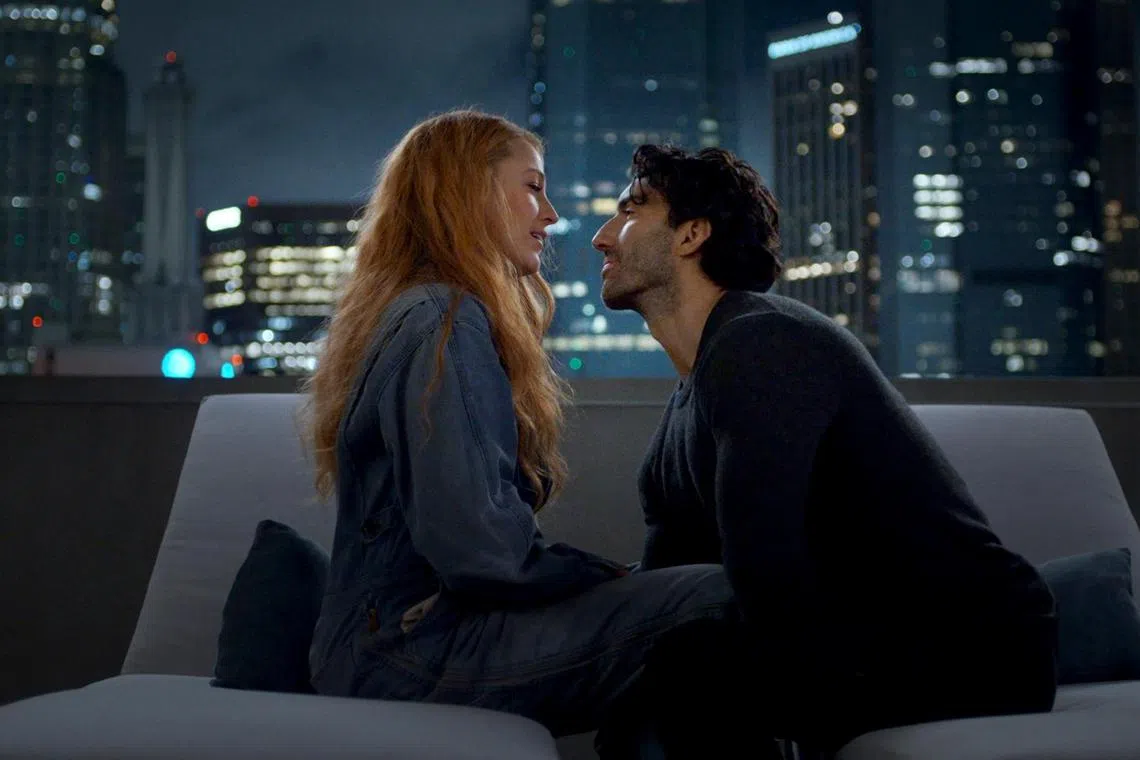What the Blake Lively movie It Ends With Us gets wrong, and right, about domestic abuse
Sign up now: Get ST's newsletters delivered to your inbox

Blake Lively (left) and Justin Baldoni in It Ends With Us.
PHOTO: SONY PICTURES
Follow topic:
NEW YORK – A person trying to escape an abusive relationship, on average, needs seven attempts to actually leave. Lily Bloom, the protagonist of the romantic drama It Ends With Us, needs only one.
In the hit film adaptation of the best-selling 2016 Colleen Hoover novel of the same name, Lily (Blake Lively) is a young woman who grew up watching her father repeatedly hit her mother and who sees her own marriage to the seemingly perfect neurosurgeon Ryle Kincaid (Justin Baldoni, also the film’s director) deteriorate into physical and emotional abuse.
When Lily learns she is pregnant with Ryle’s child after a violent night, she decides to get out.
Professionals who counsel domestic violence survivors or work on related issues say It Ends With Us is an oversimplified depiction of being in and leaving an abusive relationship. But whether it is a potential tool for advocacy or an unattainable vision of escaping abuse depends on whom you ask.
“I think it’s very likely that people are going to come to the movie and see themselves in Lily,” said Ms Pamela Jacobs, chief executive of non-profit organisation National Resource Center On Domestic Violence. She said that although It Ends With Us had problems, she was surprised by how well it showed abuse overall.
The big inaccuracy to professionals is how easily Lily leaves once she realises she is being abused. In real life, she would probably have faced stalking, harassment and other escalating pressure tactics, including violence.
In It Ends With Us, Lily and her husband peacefully part ways after a single conversation. Ms Jacobs said Lily’s departure was unrealistically smooth, thanks to her financial independence – she owns a flower shop – and unwavering community support, including from her best friend Allysa, who is also Ryle’s sister (played by Jenny Slate).
“I just hope that survivors who watch this movie don’t compare themselves too much to Lily’s story, because she was able to get away much easier than people typically are,” Ms Jacobs said.
Ms Andrea Wainer, a New York City clinical social worker and therapist who works with survivors of domestic abuse, said the movie’s message could be dangerous, as it does not explain the careful planning that goes into leaving safely.
“It’s quite a battle to leave,” she said. “If people identify that they are in abusive relationships and then after having watched this movie have the courage to leave, some will end up being killed. Many will end up without their children. Many will end up homeless and depressed, and most will have PTSD,” she said, referring to post-traumatic stress disorder.
Ms Wainer, a survivor of domestic abuse herself, said several aspects of the film rang false. Lily does not get ensnared in a custody battle, she does not face financial struggles after becoming dependent on her abuser, and she does not experience any work disruption, social isolation or the other harsh realities of escaping.
One thing the movie does get right, experts said, is the romance at the beginning of the relationship. Almost as soon as he sees Lily, Ryle is on a charm offensive, a tactic known as “love bombing”, and he plies her with flowers and insistent requests.
His controlling behaviour continues once they are in a relationship. When he hurts her, he convinces her it is only a series of accidents, and she comforts him instead. Ms Jacobs praised the focus on psychological abuse and a dynamic in which victims misread behaviours like jealousy and possessiveness as romantic.
But the movie’s marketing has also come in for criticism from experts. Much of the discussion about It Ends With Us has centred on the press tour, in part because of the dissonance between the film’s cheery, floral-heavy promotion and its dark story.
Made for US$25 million (S$32 million), the movie has earned over US$210 million at the global box office, but it is difficult to say whether it has helped viewers.

In It Ends With Us, Lily and her husband peacefully part ways after a single conversation.
PHOTO: SONY PICTURES
A spokeswoman for the National Domestic Violence Hotline said it had not seen an increase in calls tied to the movie, but it had recorded a 10 per cent rise in website traffic since the film was released in the US on Aug 9. It opens in Singapore cinemas on Sept 5.
The production company behind the movie, Baldoni’s Wayfarer Studios, partnered the No More Foundation, which focuses on awareness campaigns around domestic violence, to consult on some aspects of the depiction and to develop resources that viewers can learn about from the credits.
Compared with the same time period in July, a spokesperson said, the organisation had experienced an 800 per cent increase in website visits, three times the usual traffic to its support service directory in the US, as well as a 525 per cent increase in downloaded resources.
The group’s platform No More Silence, which invites survivors and victims of domestic abuse to safely and anonymously share their stories, has also seen a jump to more than 40 posts a week from a few since It Ends With Us was released.
“I knew this movie would change everything for me, and it did,” read one recent addition from an anonymous poster. “I finally left him and, as hard as it was, it was the best thing for me and for my future. I believe you have one life, why would I let it go to waste on someone like that?” NYTIMES
It Ends With Us opens in Singapore cinemas on Sept 5.

